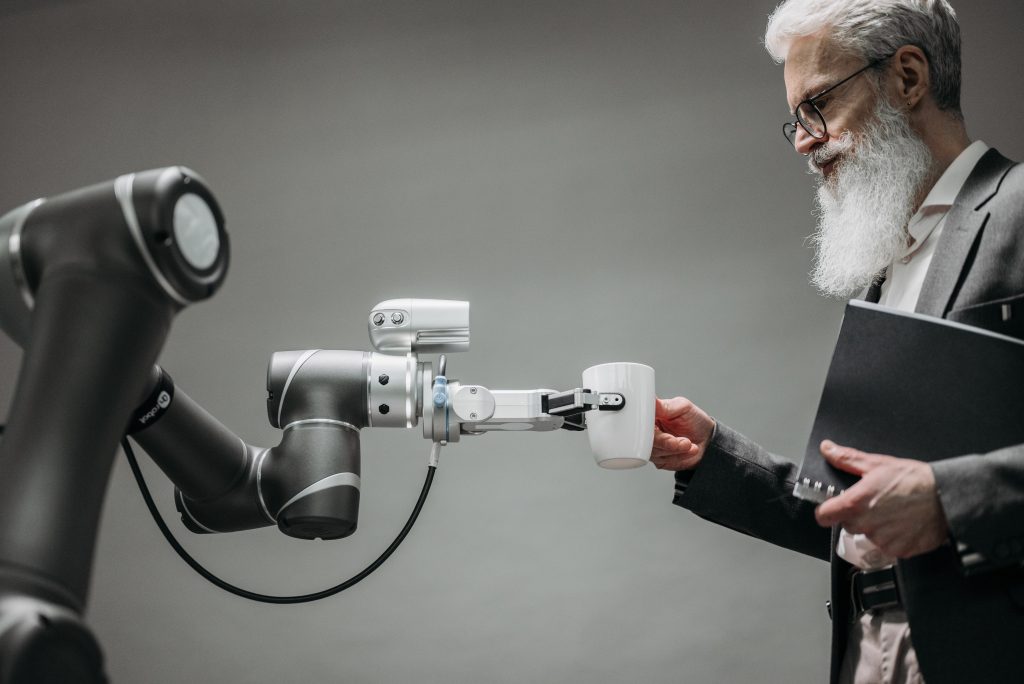AI technology has made incredible advancements in recent years, revolutionizing industries and improving our daily lives in countless ways. However, despite its impressive capabilities, there are still certain limitations that current AI technology faces. In this article, we will explore some of these limitations and how they impact the potential of AI technology. From the ability to handle ambiguity to ethical concerns, understanding these limitations is crucial in shaping the future of artificial intelligence. So let’s delve into the world of AI and discover the boundaries that still exist within this rapidly evolving field.

Misinterpretation of Data
Insufficient or incomplete data
One of the main limitations of current AI technology is the misinterpretation of data, particularly when there is insufficient or incomplete data available. AI systems heavily rely on the data they are trained on to make predictions and decisions. However, if the dataset is limited or lacks vital information, it can lead to inaccurate results. For example, an AI system trained to detect fraudulent transactions might struggle if it was not provided with enough diverse examples of fraudulent and non-fraudulent activities. Without a comprehensive dataset, the AI system may misclassify transactions, leading to false positives or false negatives.
Biases in data
Another significant concern in AI technology is the presence of biases in data. AI algorithms learn patterns from the data they are fed, and if the data itself contains biases, it can perpetuate and amplify those biases in the AI system’s predictions and outputs. This can lead to unfair and discriminatory outcomes in various domains, such as hiring, loan approvals, and criminal justice. For instance, if an AI algorithm is trained on historical data that reflects societal biases, it may make biased decisions, favoring certain groups over others. Addressing and mitigating biases in AI systems is crucial to ensure fair and equitable outcomes.
Lack of context in data
The lack of contextual understanding is another limitation of current AI technology. AI systems typically lack the ability to grasp the broader context in which data exists. They might analyze data in isolation, without considering the larger picture. This can result in misleading interpretations and flawed decision-making. For instance, an AI system analyzing customer complaints might identify certain keywords or phrases as indicators of dissatisfaction, but without the contextual understanding of the specific situation, it might fail to accurately assess the severity or urgency of the complaint. Incorporating contextual information into AI systems is essential to improve their overall performance and decision-making capabilities.
Noise in data
Noise refers to irrelevant or misleading data that may impact the accuracy and reliability of AI systems. In real-world scenarios, data can often be noisy, containing errors, outliers, or irrelevant information. If AI systems are not properly trained to handle noise, they may struggle to distinguish meaningful patterns from the noise, leading to incorrect conclusions. For example, in a medical diagnosis AI system, if the input data contains noisy measurements or inconsistent readings, it may generate inaccurate diagnoses. Developing robust techniques to filter out noise and handle noisy data is crucial to enhance the reliability and effectiveness of AI technology.
Lack of Common Sense and Understanding
Inability to think abstractly
Despite the impressive advancements in AI technology, current AI systems still struggle with abstract thinking. While they excel at pattern recognition and data processing tasks, they often lack the ability to understand abstract concepts and reasoning. For instance, an AI system might be able to identify objects in images accurately, but it may struggle to understand the underlying concepts of love or justice. Abstract thinking and understanding are fundamental aspects of human intelligence that AI systems have yet to fully replicate.
Difficulty in understanding nuances
Nuances in language, behavior, and context can pose significant challenges for AI systems. They often struggle with understanding subtle distinctions and the implied meaning behind certain words, phrases, or gestures. This limitation can lead to misinterpretation and miscommunication in AI-powered applications. For example, an AI chatbot may fail to comprehend sarcasm or irony, resulting in inappropriate responses. Overcoming this limitation requires advancements in natural language processing and the ability to capture and analyze nuanced information accurately.
Lack of intuition
Intuition, often described as a gut feeling or instinct, is another area where AI technology currently falls short. While AI systems can process vast amounts of data and make predictions based on patterns, they lack the intuitive judgment that humans possess. Intuition often involves making decisions based on incomplete information, subtle cues, or personal experiences. AI systems, on the other hand, rely on explicit data and explicit rules. Developing AI systems that can incorporate intuitive decision-making mechanisms would be a significant leap forward in enhancing their capabilities.
Inability to infer meaning from limited information
Unlike humans, AI systems struggle to infer meaning from limited or ambiguous information. Human reasoning often involves making educated guesses or filling in gaps based on prior knowledge and experience. However, AI systems heavily rely on the data they are provided and may struggle to infer accurate conclusions when faced with limited or incomplete information. This can be particularly problematic in situations where critical decisions need to be made based on partial data. Improving AI systems’ ability to reason and infer meaning from limited information is an ongoing challenge in the field.
Lack of Emotional Intelligence
Inability to recognize and respond appropriately to emotions
Emotional intelligence is a crucial aspect of human interaction and communication that AI systems currently lack. Understanding and effectively responding to human emotions is a complex task that involves recognizing various emotional cues such as facial expressions, tone of voice, and body language. While AI systems can be trained to identify these cues to some extent, they often struggle to interpret emotions accurately and respond appropriately. This limitation poses challenges in areas such as customer service, healthcare, and mental health support, where empathetic and emotionally intelligent interactions are essential.
Difficulty in understanding non-verbal cues
Non-verbal cues play a significant role in human communication, conveying emotions, intentions, and social dynamics. However, AI systems predominantly rely on textual or numerical data, limiting their ability to understand non-verbal cues effectively. For instance, an AI system analyzing customer feedback might miss important non-verbal cues that provide valuable insights into customer satisfaction or dissatisfaction. Advancements in computer vision and multimodal learning are necessary to enable AI systems to understand and respond accurately to non-verbal cues.
Lack of empathy and compassion
AI systems lack the capability of experiencing emotions, including empathy and compassion. While they can mimic empathetic responses based on pre-programmed rules or learned patterns, they do not possess genuine emotional experiences. Empathy and compassion are essential qualities in areas such as healthcare and social support, where human connection and understanding are crucial. Integrating emotional aspects into AI systems to foster empathy and compassion remains a significant challenge.
Limited ability to engage in social interactions
Social interactions involve complex dynamics, including verbal and non-verbal communication, social norms, and context-specific behaviors. AI systems often struggle to navigate and participate effectively in social interactions due to their limited understanding of social nuances and norms. For example, an AI-powered personal assistant might fail to appropriately respond to a joke or engage in small talk. Enhancing AI systems’ ability to engage in natural and socially appropriate interactions is key to their successful integration into various social domains.
Ethical and Bias Concerns
Unfair and biased decision-making
One of the prominent limitations and concerns surrounding AI technology is its potential to make unfair and biased decisions. If AI systems are trained on biased data or taught implicitly biased rules, they can perpetuate and amplify those biases in their decision-making processes. This can result in discriminatory outcomes and reinforce societal stereotypes. For example, an AI-powered recruitment system biased against candidates based on gender or race can perpetuate existing hiring disparities. It is crucial to address this limitation by ensuring diversity and fairness in datasets, as well as promoting transparency and accountability in AI systems.
Reinforcement of societal stereotypes
AI systems can inadvertently reinforce societal stereotypes by learning from biased data or modeling existing societal norms. They may replicate and perpetuate biases present in the data they are trained on, leading to biased predictions and recommendations. For instance, an AI-powered content recommendation system might reinforce gender or racial stereotypes by showcasing predominantly stereotypical content to users. To mitigate this limitation, it is important to critically examine and evaluate the training data, as well as actively work towards creating more fair and diverse datasets.
Lack of transparency in algorithms
Transparency and explainability are critical factors in building trust and acceptance of AI systems. However, many AI algorithms, such as deep neural networks, are often considered black boxes, making it challenging to understand their decision-making processes. The lack of transparency can raise concerns in high-stakes applications, such as healthcare or legal systems, where explanations for AI-generated decisions are essential. Efforts towards developing interpretable and explainable AI algorithms are necessary to address this limitation and increase the accountability of AI systems.
Privacy concerns and data misuse
AI systems heavily rely on vast amounts of data, often including personal and sensitive information. This raises concerns regarding privacy and data misuse. If not properly regulated or secured, AI systems can pose significant risks to individuals’ privacy. For instance, facial recognition technology powered by AI algorithms can infringe on people’s privacy if misused or exploited. Developing robust privacy frameworks and ensuring proper data protection measures are crucial to address these concerns and protect individuals’ privacy rights.

Limited Contextual Understanding
Difficulty in understanding sarcasm and humor
Understanding sarcasm, irony, or humor requires a deep comprehension of language, context, and cultural nuances. However, AI systems often struggle to grasp the subtleties and complexities of such linguistic expressions. As a result, they may misinterpret sarcastic remarks or fail to recognize humor, leading to inappropriate responses. Enhancing AI systems’ contextual understanding and incorporating cultural knowledge are essential to overcome this limitation and enable more accurate and contextually appropriate interactions.
Struggling with abstract concepts
Abstract concepts often go beyond the explicit data and require higher-level understanding and inference. AI systems primarily rely on explicit data patterns and struggle to comprehend abstract ideas that involve indirect or implicit information. For example, an AI system might struggle to understand the concept of “freedom” or “justice” beyond the specific instances of these ideas in the training data. Advancements in machine learning techniques that can capture and model abstract concepts would significantly enhance AI systems’ capabilities.
Challenges in identifying figurative language
Figurative language, such as metaphors or similes, is prevalent in human communication and often conveys abstract concepts or emotions. However, AI systems face difficulties in recognizing and interpreting figurative language accurately. They may interpret metaphoric expressions literally, leading to miscommunication and misunderstanding. Developing AI models that can understand and appropriately respond to figurative language would greatly enhance their language processing capabilities.
Lack of knowledge beyond the provided dataset
AI systems are limited to the knowledge and information present in the datasets they are trained on. They often struggle to generalize and apply knowledge beyond the specific context of the training data. For example, an AI language model trained on news articles might have limitations when asked to generate creative fictional stories. Building AI systems that can tap into broader knowledge sources and generalize beyond the training data remains a challenge.
Lack of Creativity and Originality
Inability to generate novel ideas
Creativity is a distinct human trait that AI systems currently lack. While AI algorithms can generate content based on learned patterns, they struggle to produce truly original and innovative ideas. This limitation becomes evident in domains such as artwork, literature, or music, where creativity and originality are highly valued. Advancements in AI creativity, such as generative models and creative machine learning algorithms, are ongoing research areas that aim to overcome this limitation and unlock new possibilities.
Limited ability to think outside the box
Thinking outside the box involves approaching problems from unconventional perspectives and challenging established norms. AI systems, primarily driven by data and explicit rules, often struggle to devise unconventional or innovative solutions. Their decision-making processes are restricted to the patterns and knowledge present in the training data. To enable AI systems to think more creatively, researchers are exploring techniques such as computational creativity, which aim to imbue AI models with the ability to generate novel and unconventional solutions.
Difficulty in adapting to new situations
AI systems that are trained for specific tasks or domains often struggle to adapt to new situations or contexts. They are designed to perform well within the specific parameters of their training data, but their performance might degrade when faced with scenarios they have not been explicitly trained on. This limitation is known as the “brittleness” of AI systems. Enhancing AI systems’ adaptability to new situations and enabling them to generalize from limited training data are active areas of research.
Low capacity for innovation
While AI technology has made significant strides in automating routine tasks and improving efficiency, it currently lacks the capacity for genuine innovation. Innovation involves identifying novel ideas, combining existing knowledge in new ways, and pushing the boundaries of what is possible. AI systems, with their reliance on existing data patterns and rules, often fall short in this aspect. Overcoming this limitation would require advancements in AI algorithms, such as developing systems that can actively explore and experiment with different approaches, enabling them to contribute to innovation processes.

High Resource and Energy Requirements
Demand for extensive computational power
Current AI technology often requires substantial computational power to train and operate AI models effectively. Training complex deep learning models can be computationally demanding and time-consuming, requiring specialized hardware resources such as GPUs or TPUs. The computational requirements pose challenges in terms of accessibility and scalability, limiting the widespread adoption of AI technology. Efforts to optimize algorithms and develop more efficient hardware architectures are ongoing to address this limitation.
Need for vast amounts of data storage
Another limitation of current AI technology is the need for extensive data storage capabilities. AI models often require large amounts of data for training, which can pose challenges for organizations with limited storage capacity. Moreover, storing and managing massive datasets raises concerns regarding data security and privacy. Developing efficient data storage solutions and data management strategies are essential to handle the growing demands of AI systems.
Energy consumption and environmental impact
The high resource requirements of AI systems, including computational power and data storage, result in significant energy consumption. Data centers powering AI infrastructure consume substantial amounts of electricity, contributing to carbon emissions and environmental impact. As AI technology becomes more widespread, addressing the energy footprint and environmental implications of AI systems is crucial. Developing energy-efficient hardware, optimizing algorithms for reduced energy consumption, and promoting renewable energy sources are necessary steps to mitigate this limitation.
Cost-prohibitive for widespread adoption
The resource requirements, including computational power, data storage, and energy consumption, often make AI technology costly for widespread adoption. Small organizations or individuals with limited financial resources might find it challenging to access and utilize AI systems effectively. The cost-prohibitive nature of AI technology can lead to disparities in its adoption and may limit its potential benefits. Exploring cost-effective solutions and promoting accessibility to AI technology are crucial to ensure broader participation and democratization.
Limited Transfer Learning
Challenges in reusing knowledge from one task to another
Transfer learning refers to the ability of AI systems to leverage knowledge learned from one task or domain and apply it to another related task or domain. However, current AI technology still faces challenges in effectively reusing knowledge across different tasks. Transfer learning requires identifying relevant features and patterns from one domain and applying them appropriately in a different context. Overcoming the limitations of transfer learning would enable AI systems to learn more efficiently from limited data and generalize across various domains.
Difficulty in generalizing across different domains
AI systems often struggle to generalize their knowledge and capabilities across different domains. While they can excel in specific tasks they are trained on, their performance may suffer when applied to new and unfamiliar domains. For instance, an AI system trained to identify objects in images might struggle when confronted with a completely different domain, such as medical images. Enabling AI systems to generalize effectively and transfer their learned knowledge to new domains remains a significant challenge.
Lack of adaptability to new circumstances
Adaptability is a critical aspect of intelligence that current AI systems often lack. Human intelligence allows individuals to quickly adapt to new circumstances, learn from experience, and adjust their behavior accordingly. AI systems, on the other hand, heavily rely on predefined rules and patterns, making it challenging for them to adapt to unforeseen situations. Robust and adaptive AI systems capable of learning on the fly and adapting to changing environments are essential for overcoming this limitation.
Inability to leverage past experiences effectively
While AI systems can learn from vast amounts of data, they often struggle to leverage past experiences effectively. Human intelligence relies on memory to recall and apply knowledge learned from previous encounters. AI systems, despite their data-driven learning capabilities, have limitations when it comes to leveraging past experiences to inform current decision-making. Advancements in memory-based and lifelong learning approaches aim to address this limitation and enable AI systems to more effectively utilize past experiences.

Safety and Security Risks
Unintended consequences and errors
AI systems, especially those employing complex algorithms or deep learning models, pose risks of unintended consequences and errors. The reliance on data patterns and rules can lead to unexpected behaviors or outcomes when faced with scenarios outside the training data. For example, an autonomous vehicle AI system may encounter unforeseen situations on the road that it was not explicitly trained for, resulting in unpredictable behavior. Ensuring the safety and reliability of AI systems through rigorous testing, validation, and risk assessment is crucial to mitigate these risks.
Vulnerability to adversarial attacks
Adversarial attacks involve deliberately manipulating input data to deceive or confuse AI systems. AI models, relying on statistical patterns and features in the data, can be vulnerable to such attacks. Adversarial attacks can have serious consequences, such as misclassifying images or tricking AI systems into making incorrect predictions. Developing robust defenses against adversarial attacks and improving the resilience of AI systems to adversarial manipulation are ongoing research areas to enhance the security of AI technology.
Potential for malicious use of AI
While AI technology brings numerous benefits, it also carries potential risks of malicious use. AI systems can be exploited or weaponized to perform harmful actions or generate malicious content. For instance, AI-powered spam generators or deepfake technologies can be misused for propaganda or spreading disinformation. Safeguarding against the malicious use of AI requires ethical considerations, responsible use, and regulatory frameworks to prevent misuse and protect against potential harm.
Lack of accountability and transparency
The lack of accountability and transparency in AI systems poses challenges in ensuring responsible and reliable use of the technology. When AI-powered systems make decisions or recommendations, it is critical to understand the underlying processes, rules, and data that inform those decisions. However, many AI algorithms and models are considered black boxes, making it difficult to trace their decision-making processes. Enhancing transparency, explainability, and accountability in AI systems is paramount to address this limitation and build trust in their usage.
Dependency on Human Input and Supervision
Need for human intervention in training and fine-tuning
AI systems heavily rely on human intervention during the training and fine-tuning processes. Human experts are typically required to label or annotate large amounts of data for supervised learning algorithms. They are also responsible for setting appropriate parameters, selecting relevant features, and evaluating the system’s performance. The need for human involvement makes the development and deployment of AI systems resource-intensive and time-consuming. Exploring methods to reduce human dependency while maintaining high-performance standards is an active research area.
Limited autonomy without constant human control
AI systems often require constant human control and supervision to ensure their proper functioning and prevent undesirable outcomes. They may lack the ability to reason, make judgment calls, or adapt to changing circumstances independently. This limitation limits the autonomy of AI systems and hampers their effectiveness in situations that demand real-time decision-making. Advances in AI technology aim to develop more autonomous systems that can operate with reduced human intervention while maintaining safety and reliability.
Reliance on experts to provide labeled data
The success of many AI algorithms relies on the availability of accurately labeled or annotated datasets. Human experts typically play a crucial role in providing labeled data for supervised learning tasks. Their expertise and domain knowledge are essential in defining the ground truth and training AI models effectively. However, accessing and engaging domain experts can be challenging, especially in niche domains or when experts are unavailable or expensive to involve. Developing techniques for more efficient labeling and reducing the dependency on scarce expert resources would enhance the scalability and accessibility of AI technology.
Difficulty in verifying and validating output
AI systems’ outputs, especially in complex domains like healthcare or finance, often require verification and validation by human experts. Ensuring the accuracy and reliability of AI-generated results is crucial, as errors or incorrect predictions can have severe consequences. However, verifying and validating the output of AI systems can be challenging due to the complex and opaque nature of many AI algorithms. Developing robust evaluation methods and quality assurance processes that incorporate human expertise are necessary to address this limitation and ensure the trustworthiness of AI systems.
In conclusion, current AI technology possesses several limitations that impact its performance, applicability, and ethical implications. These limitations include misinterpretation of data, lack of common sense and understanding, limited emotional intelligence, ethical and bias concerns, limited contextual understanding, lack of creativity and originality, high resource and energy requirements, limited transfer learning capabilities, safety and security risks, and dependency on human input and supervision. Addressing these limitations and advancing the field of AI requires ongoing research, collaboration, and ethical considerations to harness the full potential of AI technology while ensuring its responsible and equitable use.










